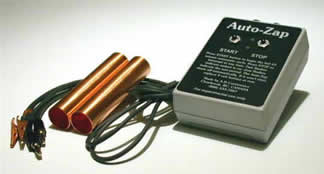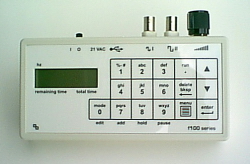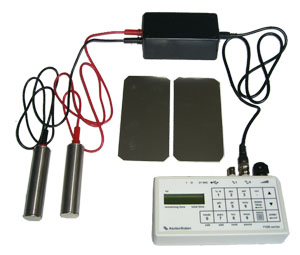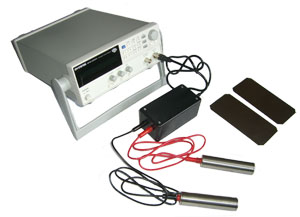Recommendations for those who want to explore bioelectronic devices
See the Introduction to Bioelectronic Therapies page for a more detailed explanation of some of the devices described in the article below.
-------------
Zapper
If resources are very limited, a Hulda Clark zapper can be built oneself using the directions available online or in any of her books for about $20 in parts (or for less than $10 premade in some cases - see below). For those more technically inclined, Richard Loyd provides an advanced zapper schematic on his website.
Premade zappers are
widely available and cost in the $30 to $150+ range. They are the device
that most people who are exploring bioelectronics start with. Plus, for many
people, a zapper provides the only device necessary to solve some problems or
provide effective maintenance. There are many manufacturers of zappers online these days and I have not been keeping up with them to see which provide the best value. Since most people will forgo using the wet paper towels on their zapper handholds and just grab onto the copper, which is NOT recommended, a zapper with stainless steel handholds, or better yet, one which can connect to TENS pads with tip plug cables, is recommended. The best zapper was made by Sota Instruments, but is no longer available due to government pressures. See the Bioelectonic Therapies article for more information.
ZapperGuy (formerly TenDollarZapper) is a company which once sold most of their products on ebay but now has a web storefront. They specialize in professionally made inexpensive zappers, but now also make advanced models. The basic model is called the Sub-Micro zapper which now costs $15 to $21 and is a small circuit board integrated into the cable - just connect a 9v battery and either pads, wrist straps, or copper electrodes (available for extra cost, or provide your own). A disadvantage of the basic zapper is that it does not have an on-off switch so the battery must be disconnected to stop the output but for the low cost, this is easily overlooked. Various electrodes such as silver-wire impregnated wrist straps, snap-typeTENS pads with cables, and copper pipe electrodes are all available for a reasonable cost. TenDollarZapper also sells more advanced models, which are highly recommended. There is a single frequency mini model built into a very small case that comes with electrodes and has a switch. The most advanced unit they offer is the Z4e Extreme High Power Zapper which is a three frequency model capable of producing 15Hz, 2.5KHz, and 30KHz. It is similar in capability to the discontinued Sota multifrequency zapper.
Note that pads used for zappers and pad devices come in two types - those made for pin (tip plug) outputs and those made for snaps. Tip plugs are available inexpensively and the non-solder type can be screwed onto the end of an insulated wire (strip the end to expose an inch or so of the inner conductor and screw it on.). See text below for further information on tip plugs, tip jacks, and other connectors.
Another zapper that is still available is the Auto-Zap Hulda Clark Zapper. It is an automated unit which runs the 7 minutes on, 20 minutes off Clark protocol automatically, which electroherbalism considers a disadvantage since it is not useful for long, continuously on sessions which as necessary in some cases, but it a good method to start with. It is also good in that it incorporates battery and output tests to ensure no wires are loose and that there is sufficient output to be effective. It includes copper handholds. Copper pipes are recommended by Hulda Clark for her zapper since they are easy to make and copper pipe is  cheap and readily available. However, they must be used with wet paper towels around them to prevent the copper from entering the body (see Zapper Tips). After a while, many people forgo using the paper wraps altogether for convenience, in which case it is better to use stainless steel handholds. A company called PacificGen sells stainless steel handholds with cables on their products page that will work with the Auto-Zap zapper or the ZapperGuy models.
cheap and readily available. However, they must be used with wet paper towels around them to prevent the copper from entering the body (see Zapper Tips). After a while, many people forgo using the paper wraps altogether for convenience, in which case it is better to use stainless steel handholds. A company called PacificGen sells stainless steel handholds with cables on their products page that will work with the Auto-Zap zapper or the ZapperGuy models.
Warning : One of the reasons people like using TENS pads is because it allows them to sleep while using a pad device. However, if a pad is starting to pull away and is only stuck on with a small area, the current density can be too high and it can cause a burn on the skin, especially when using a high powered device! Sleeping with pads while running a session is not recommended, but if it is done, use velcro straps to secure the pad so it does not pull off. Also, if using the device during sleep or for long periods, a low voltage should be used, no more than 9V.
An even better solution is to use TENS pads. Although TENS pads are a continuing expense, they are stuck on the wrists, ankles, or anywhere else, and allow the user to do a zapper session without the inconvenience of holding onto the handholds. To use TENS pads on an Auto-Zap zapper requires banana jack cables and a banana plug to tip plug adapter (Pomona 1432) or banana plug to tip plug cables - look for 6 ft long ones. There are also banana plug to tip plug cables available, but these are harder to find in a 6 ft length. This allows standard TENS pads to be used with zappers that have a banana jack output. TENS pads (called TENS electrodes) are available inexpensively at Wisdom King. Thery are available in many different sizes, are reasonable in cost, and last as much as 30 uses if proper care is taken.
Function Generator Pad Device
The next step up from a zapper is using a function generator in pad device mode. This allows separate frequencies to be run, not just the fixed single
A pad device is one in which the user is connected directly to the frequency device using wires connected to handholds, footplates, or actual pads, such as TENS pads. A radiant device is one where the user is not connected directly to the device and usually has a tube stimulated with RF or high voltage.
frequency of a zapper. Note that many sellers call a function generator pad device like this a "Rife device" or "Rife generator" but it is usually just a function generator running audio range Rife frequencies with or without a carrier signal.
An Atelier Robin function generator is excellent as a "rife generator" contact pad device since it will operate in standalone mode. It has two outputs, one TTL (always 5v) and another which is adjustable from 0-12v (or -12 to +12v in biphasic mode, which is not typically used for pad devices). It comes with a power supply and a USB cable that is used to load the frequency files from a PC (see the Atelier Robin Function Generator page for folders of hundreds of premade frequency files), but it does not include cables or electrodes to allow it to be used in pad device mode.
 To use an F125 by itself as a "pad device" requires a few additions.
To use an F125 by itself as a "pad device" requires a few additions.
To make a pad device out of an F125 using TENS pad for the output (the most convenient method), the following items are needed:
1. BNC male to banana jack test adapter such as this one from L-com. This plugs into the adjustable output of the F125 and allows standard banana jack cables to be used.
2. Two banana plug cables, preferably one red and one black. These are commonly available, even at Radio Shack, but look for ones which are 6ft or longer.
3. Two banana plug to tip plug adapters, such as the Pomona 1432-0 (black) and 1432-2 (red) available at Mouser Electronics. These plug into the ends of the banana cables to give them tip plug ends, which are required to plug into standard TENS pads.
4. TENS pads. The best have silver conductors such as the UNP627SS (2" round) or UNP617S (2x3.5" rectangle) from Wisdom King. They come four to a package (2 sets of 2).
Instead of using TENS pads, stainless steel handholds can be used if one would rather use this type of electrode. The stainless steel handholds that Pacific Health (see below) sells take a banana plug input. If these are used instead of TENS pads, no banana plug to tip plug adapters or TENS pads are needed.
 For a complete, out-of-the-box "rife" pad generator device solution, a good choice is PacificGen, which sells two models of function generators, one programmable and one not. The programmable one is called a Programmable Blaster and is based on an Atelier Robin F125 function generator and the non-programmable one is an Intek function generator with keypad input. Both come with a 10W amplifier, cables, and stainless steel handholds and foot pads. Given the capabilities of the Atelier Robin function generator with its ability to hold over 1000 frequency files (download a set of hundreds of them in the Atelier Robin Function Generator section), ability to easily create or download frequency files, multichannel and carrier signal capabilities, and the addition of the necessary components for use out of the box, plus the 10W amplifier, this setup is more capable than most others on the market which can cost as much as $3000 or more.
For a complete, out-of-the-box "rife" pad generator device solution, a good choice is PacificGen, which sells two models of function generators, one programmable and one not. The programmable one is called a Programmable Blaster and is based on an Atelier Robin F125 function generator and the non-programmable one is an Intek function generator with keypad input. Both come with a 10W amplifier, cables, and stainless steel handholds and foot pads. Given the capabilities of the Atelier Robin function generator with its ability to hold over 1000 frequency files (download a set of hundreds of them in the Atelier Robin Function Generator section), ability to easily create or download frequency files, multichannel and carrier signal capabilities, and the addition of the necessary components for use out of the box, plus the 10W amplifier, this setup is more capable than most others on the market which can cost as much as $3000 or more.
 Either of the Pacific Health generators can be used to drive a Rife-Bare device (used without the amplifier) but it is highly recommended to get the Programmable Blaster (shown above right), for long terrm use since manually entering frequencies every three minutes even with a keypad is grueling. Note that the Pacific Health cables have a banana plug output so to use this device with TENS pads, which may be preferred for long term use for the convenience of not having to hold onto the tubes or use the foot plates, it is necessary to use a banana jack to tip pin plug adapter, which are available cheap (the Pomona Electronics 1432 is one), or Pacific Health will premount a tip pin plug instead of banana plug if desired. Note that the Atelier Robin F125 used in this device has a maximum frequency of 1.5MHz on one channel and 400KHz on the other, which is fine for most pad device work, but for those who wish to run up to 20MHz (of questionable use in pad devices due to skin effect), an upgrade to the Atelier Robin F165 is necessary.
Either of the Pacific Health generators can be used to drive a Rife-Bare device (used without the amplifier) but it is highly recommended to get the Programmable Blaster (shown above right), for long terrm use since manually entering frequencies every three minutes even with a keypad is grueling. Note that the Pacific Health cables have a banana plug output so to use this device with TENS pads, which may be preferred for long term use for the convenience of not having to hold onto the tubes or use the foot plates, it is necessary to use a banana jack to tip pin plug adapter, which are available cheap (the Pomona Electronics 1432 is one), or Pacific Health will premount a tip pin plug instead of banana plug if desired. Note that the Atelier Robin F125 used in this device has a maximum frequency of 1.5MHz on one channel and 400KHz on the other, which is fine for most pad device work, but for those who wish to run up to 20MHz (of questionable use in pad devices due to skin effect), an upgrade to the Atelier Robin F165 is necessary.
Note that a major benefit of owning a standard function generator pad device is that if it is decided to upgrade to a plasma tube Rife-Bare or EMEM device in the future, the function generator can be used to drive it.
A bane of people exploring bioelectronic therapies is when they do not do the proper research and buy a function generator pad device which uses codes instead of frequencies. These coded function generators have a limited number of frequencies and hide the true frequency which is running from the user. Although easy to use since one need not worry about programming them since they typically have hundreds of programs which are ready to run, when the user finds new frequencies or programs to run that are not in the list, they are out of luck. A device called the Detox Box, shown at right, is a coded function generator, but more user friendly since it contains 473 built-in auto-codes but also allows one to assign codes for up to 100 user-defined autocodes from a choice of 250 frequencies. If a coded function generator is desired for whatever reason, at least this one is expandable. Unlike other coded function generators, the Detox Box also provides a decode list of the codes versus frequencies so one can determine the actual frequencies running if desired.
------------ Original Article -----------
The original article Recommendations for those who want to explore bioelectronic devices below is outdated but still included for hstorical purposes.
------
People are always asking me something like, "What would be the best investment for me to make as far as purchasing an experimental bioelectronic machine? I can't afford a Rife Bare."
If resources are very limited, a Hulda Clark zapper can be built oneself using the directions available online or in any of her books for about $20 in parts. Premade zappers are widely available and cost in the $50 to $100+ range. They are the device that most people who are exploring bioelectronics start with. Plus, for many people, a zapper provides the only device necessary to solve some problems or provide effective maintenance. There are many manufacturers of zappers online these days and I have not been keeping up with them to see which provide the best value, Since most people will forgo using the wet paper towels on their zapper handholds and just grab onto the copper, which is NOT recommended, a zapper with stainless steel handholds, or better yet, one which can connect to TENS pads with tip plug cables, is recommended. The best zapper was made by Sota Instruments, but is no longer available due to FDA pressures.
The next step up is to get a pad-capable function generator. Pad-capable means it has a higher output than the typical 3 to 5v, and usually produces 12v or more. WIth these, specific frequencies and frequency sets can be used, like those in the CAFL. The best ones are programmable. I highly recommend this type since it gets very tiring punching in a new frequency every three or so minutes for long sets. Two generators that meet this criteria are listed below. Prices, specs, and capabilities stated are at the beginning of 2002.
ProGen - 0 to 999,999Hz. 14V output, either positive, negative, or biphasic. Has 40 banks of up to 50 levels each. Levels can be single frequencies or scans up to 9Hz. Each level can have a different gating rate (0-9999Hz). Includes sample protocols preprogrammed in some of the banks, which can be overwritten if desired.It works excellent in a Rife Bare device since it has by far the best immunity from RF interference. Cost: $900
The F100 Series function generators are standalone generators which are loaded from a PC (with a USB cable) with up to 1500 program files that are easily transferrable. Has two outputs - one 5v TTL and the other 0-12V adjustable. Excellent for use as a pad device.
See Wisdom King or Vitality Medical for good deals on TENS pad electrodes which can be used with these devices. Note that TENS pads typically need a tip plug input cable, not a banana plug, but unless the banana plug is soldered to the cable, it is usually easy to interchange tip plug and banana plug ends. There are also banana to tip plug adapters available such as the Pomona 1432 which can be plugged into banana cables to allow them to interface with TENS pads that have a tip plug input.
These prices may not include pads or electrodes, wires, or power supplies (they can use those little transformers that plug into the wall). Some people get one of these function generators, a power supply, lead wires that plug into the generator, and TENS pads or handholds to use them as pad devices. Like a zapper, this may be all that is necessary to address many health issues. A major benefit of these generators is that they can be used as inputs to EMEMs and Rife Bare generators.
An EMEM is a high voltage driver which powers a plasma tube. The function generators above can be used as the input for most EMEMs. It provides greater penetration and usually better results than pad devices like zappers and plain function generators. They are usually used in contact mode where the tube is held, but also work in radiant mode, just sitting close to the tube.
One version of an EMEM was developed by Jimmie Holman (whose website has disappeared as of late 2006), who called it the Poor Man's Rife. It could be built easily if his "high voltage" brick was purchased for about $200. The Allred Neon tubes which are usually used in this device cost from $50 to $100+ depending on the design. A 4-5A or higher power supply is needed and these cost $30-40. Add a few cables and the cost of the function generator and it is around $1000. Pretty good price given it is fully programmable. Other EMEM plans are given on Richard Loyd's website. The problem with this and some other EMEM devices is that a variable duty cycle function generator is really needed to properly drive them at commonly used rife frequencies.
Popular premade EMEM devices are available from Bruce Stenulson. His have the capability of different power output levels, a timer, and other features. They also have a built-in square wave generator. Presently, you must connect an external frequency counter or multimeter to display the frequency and tune coarse and fine adjustment knobs to set the frequency, and this must be done each time a new frequency is set. Or, it can use one of the function generators above to provide a programmable input and this is highly recommended if more than a few frequencies will be run per session.
The function generator can also be used in a Rife Bare. These devices produce RF so the tube cannot be held. It may penetrate the body best, but usually does not create the powerful sensation that pad devices and EMEMs used in contact mode produce. To build a Rife Bare, order James Bare's construction manual called "Resonant Frequency Therapy - Building The Rife Beam Ray Device."Resonant Light Technology makes a professional Rife-Bare device, is well-respected, and has been around the longest. Other trustworthy manufacturers of plasma tube devices, and who are currently making the most advances in this technology, include TrueRife, Zapperstore, and PacificGen.